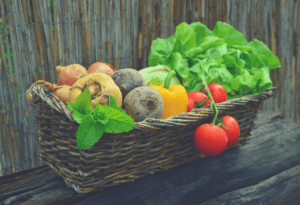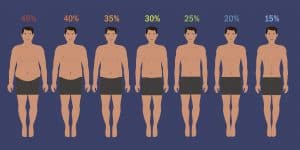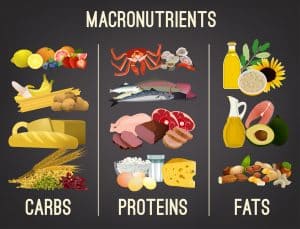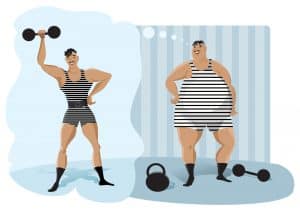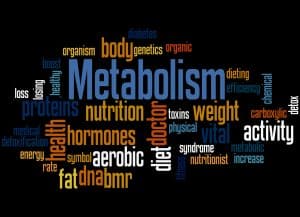After completing my bulking cycle, it was time to target my ripped physique.
In an attempt to achieve this, carbs were off the menu—regardless of how healthy they were. Thanks to fad diets, I was convinced they were the culprit of weight gain.
Then I discovered that I don’t have to restrict them to drop the fat—the answer lies in, being selective and blood sugar levels.
Here’s what I learned about a low glycemic diet for fat loss and muscle maintenance.
What Is a Low Glycemic Diet?
A low glycemic (low GI) diet follows the principles of the glycemic index.
When you consume carbohydrates, your digestive system breaks it down into glucose to fuel your body. However, not all carbs are the same—different types have varied effects on blood sugar.
The glycemic index (GI) is a scale that assigns a number to carbohydrates based on how much they influence your blood sugar levels. A lower number indicates a lesser impact, while a higher ranking means it has a more significant consequence.
The GI ratings are as follows:
- Low—55 or less.
- Medium—56-69.
- High—70 or more.
The main bulk of your diet should focus on foods within the lowest tier. Medium-GI foods are eaten less frequently, and adherents of the diet aim to avoid high-GI foods.
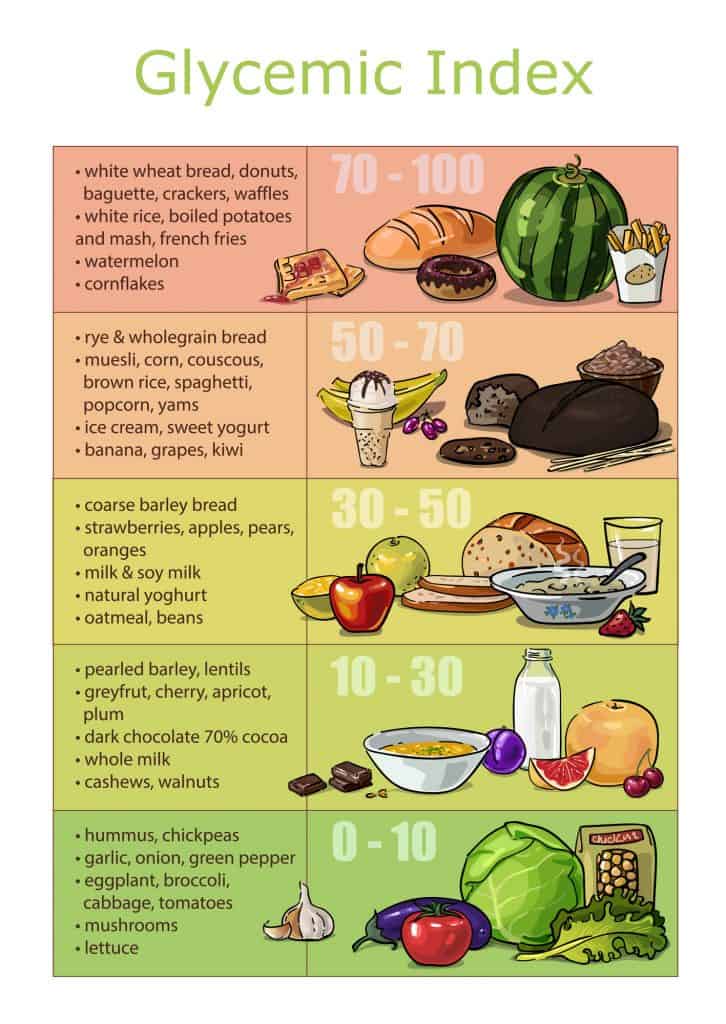
Benefits of a Low Glycemic Diet
A. The Four Fitness Benefits
1
Increases Energy Levels
Foods with a high glycemic index consist of carbs that cause a rapid rise and fall in blood sugar levels—resulting in a quick burst of energy followed by a “crash.”
Your digestive tract processes low glycemic foods at a much slower pace. As a result, the conversion of carbs to glucose is more stable—there isn’t a spike, but rather, a gradual rise in blood sugar and insulin.
This creates a steadier supply of energy—enhancing your training sessions.
2
Suppresses Appetite
The reduction in blood sugar spikes can help cut cravings and urges. Foods with a lower glycemic index generally also contain moderate to high amounts of fiber—keeping you fuller for longer.
Additionally, research suggests a connection between the elevation of gut hormones and low GI food intake. The satiating glucagon-like peptide (GLP-1) increases in production—thus, appetite control—at a rate of 20% more than its high glycemic equivalents.
3
Inhibits Fat Storage
Insulin has a primary role in storing fat and glucose. The level of secretion correlates to the levels of blood sugar circling your body—the more glucose present the more insulin.
As we’ve seen, following a low glycemic diet keeps blood sugar down—detering insulin production.
The outcome—fat oxidation (fat burning) increases, therefore, you’re less likely to accumulate body fat.
4
Fat Loss
Combine the above advantages, and you’re in the optimal scenario to cut the unwanted pounds.
Studies prove that a low glycemic diet can lead to a loss of 1.5–4.2 pounds (0.7–1.9 kg) over 5–10 weeks.
B. The Four Health Benefits
- Diabetes—following a low glycemic diet can delay or avert potential complications of this condition. Studies also indicate that a rise of five GI points increases the risk of developing type 2 diabetes by 8%.
- Cholesterol—a low-GI diet reduces LDL (bad) cholesterol.
Foods to Eat on a Low Glycemic Diet
A low glycemic diet focuses on whole foods containing fiber, and starches that are slowly converted into glucose.
These include:
- Food to Eat
- Bread—wholegrain, rye, multigrain, tortilla (whole grain) and sourdough.
- Pasta—pasta and noodles (not containing cornstarch).
- Rice—brown, brown basmati, wild and long-grain.
- Breakfast cereals—steel-cut oats and muesli.
- Fruit—oranges, grapefruit, lemons, limes, berries, pomegranate, honeydew melon, apples, peaches, and pears.
- Vegetables—asparagus, broccoli, cauliflower, zucchini, yams, parsnips, tomatoes, eggplant, and celery.
- Starchy vegetables—carrots, sweet potato, butternut squash, and pumpkin.
- Legumes—beans, peas, lentils, and chickpeas.
- Nuts and seeds (also a rich source of fats and protein)—almonds, walnuts, cashews, pistachios, macadamia nuts, flaxseeds, hemp seeds, chia seeds, and pumpkin seeds.
- Grains—quinoa, barley, couscous, and popcorn.
- Dairy—milk, soy milk, nut milk, cheese, and yogurt.
- Tofu and mock meats.
Foods that don’t contain carbohydrates aren’t given a GI-value. However, you should include healthy fats and protein in any balanced diet. Include these foods in your low glycemic diet:
- Meat—beef, chicken, pork, and lamb.
- Fish and seafood—salmon, trout, tuna, sardines, pilchards, and shellfish.
- Eggs.
- Fats and oil—butter, margarine, olive oil, avocado oil, and sunflower oil.
Foods to Avoid on a Low Glycemic Diet
Cutting out high-GI foods isn’t completely necessary on a low glycemic diet—however, try replacing them with lower GI alternatives whenever possible.
High-GI foods include:
- Food to Avoid
- Bread—white bread, hamburger and hotdog buns, pita bread, naan, bagels, kaiser rolls, and baguettes.
- Pasta—instant noodles and pasta made with corn starch.
- Rice—Jasmine, sticky, instant, and white rice.
- Breakfast cereals—instant oats, Corn Flakes, sweetened, puffed wheat, crisped rice.
- Fruit—watermelon, banana (over-ripened).
- Starchy vegetables—instant mashed potatoes, sweet corn, and boiled white potatoes.
- Rice milk.
- Pizza.
- Pastries and waffles.
- Cakes and biscuits.
- Candy and fruit roll-ups.
- Sugary Soda, and processed fruit juice.
- Savory snacks—rice crackers, pretzels, and potato chips.
Natural fruit juice has a high glycemic index but consists of a lot of vital micronutrients. Drink it with fiber-rich foods to avoid a sudden blood sugar elevation.
Working out on a Low Glycemic Diet
A. Before Workout
When performing intense physical activity, your body burns off stored energy and reverts to glycolysis—the process of converting carbohydrates into energy to fuel your body.
Carb-loading before a tough workout is essential—or your body will burn the nutrients needed to build muscle. However, high-GI carbs won’t give you a reliable, consistent supply of energy for an intense training session.
Consume a meal that includes a moderate amount of protein and low-GI carbs about 60-90 minutes before your workout. This timing is important—your body needs time to convert the food into energy so that it’s ready to utilize.
The best pre-workout carbs include:
- Steel-cut oats.
- Fresh fruit.
- Dried fruits.
- Whole-grain bread or toast.
- Sweet potatoes.
- Pasta (without cornstarch).
- Beans and lentils.
Protein intake before working out enhances muscle protein synthesis. Top sources include:
- Lean meats.
- Tofu.
- Eggs.
- Beans and lentils.
- Protein supplements.
If you’re pressed for time—blend protein powder, whole fruit, and water (or milk) 30 minutes before your workout—or eat one piece of fruit five minutes prior.

B. Post Workout
Refueling post-exercise is also crucial—it supplies your muscles with the nutrients needed to recover and build.
Aim to make your post-workout meal 15-20% of your daily caloric intake—and ensure it consists of protein, healthy fats, and high-quality, low glycemic carbs.
If you’re not up for eating a meal right after working out—go for liquid. Blend a smoothie of protein powder with whole fruits and milk—consume it within 30 minutes of your session. Consume a solid meal no later than 90 minutes after your training.
Ideal foods for a post-workout meal include:
- Meat—beef, chicken, pork, and lamb.
- Fish and seafood.
- Tofu and mock meats.
- Protein supplements.
- Eggs.
- Dairy—milk, cheese, and yogurt.
- Plant-based dairy alternatives.
- Nuts and seeds.
- Healthy cooking oils—olive oil, avocado oil, sunflower oil, and rice bran oil.
- Low glycemic pasta.
- Rice—brown rice, basmati, wild rice, and long-grain.
- Low-GI bread.
- Vegetables—broccoli, cauliflower, zucchini, tomatoes, eggplant, and celery.
- Starchy vegetables—potatoes, sweet potato, butternut squash, and pumpkin.
- Legumes—beans, peas, lentils, and chickpeas.
- Fruit—berries, apples, peaches, plums, pears and apricots.
- Breakfast cereals—steel-cut oats and muesli.
On the days that you workout, your body burns more calories, even at rest. To ensure that your energy stores don’t deplete overnight, eat an easily-digested protein snack one to two hours before bed.
Examples include:
- Cottage cheese with fruit.
- Chicken breast or tofu.
- Omelet.
- Celery or carrots with nut butter.
- Egg and avocado on toast.
Low Glycemic Meal Plan
I’ve devised a five-day meal plan based on the above guidelines. You don’t need to follow it to the letter—you can swap foods for similar items according to your taste buds and dietary requirements.
The snack options can also serve as pre or post-workout meals—if you eat 30 minutes before or after exercising.
Day 1
Meal 1
1 cup steel-cut oats. ½ cup of milk. One sliced banana. ½ cup of berries. ½ oz flaxseeds, chia seeds or hemp seeds. 1 oz mixed nuts.
Meal 2
2 cups minestrone soup. Two slices of whole-grain bread or toast with butter or margarine. 2 oz cottage cheese. 1 cup broccoli.
Meal 3
Two skinless chicken breasts. 1 cup brown rice. ½ cup of cooked asparagus. One sweet potato.
Meal 4
½ cup yogurt. 2 oz almonds or cashews.
Meal 5
1 cup milk. One scoop protein powder. ½ banana.
Day 2
Meal 1
Mushroom and green pepper omelet. 1 cup muesli. ½ cup milk. One grapefruit.
Meal 2
Bowl of romaine lettuce. Tomatoes. Cucumber. Olives. Feta cheese. Ranch dressing. 1 cup spiced sweet potato wedges.
Meal 3
4 oz grilled salmon. 1 cup quinoa. Carrots. Brussel sprouts.
Meal 4
Celery sticks. 2-3 oz peanut or almond butter.
Meal 5
1 cup milk. 1-2 scoops protein powder. ½ cup blueberries or raspberries.
Day 3
Meal 1
1 cup steel-cut oats. Mango slices. Kiwi slices. 2 oz almonds.
Meal 2
1 cup couscous. 1-2 grilled peppers. 4 oz sardines.
Meal 3
4 oz roasted lamb. 1 cup roasted cauliflower with melted cheese. ½ cup green peas.
Meal 4
½ cup trail mix. 1 oz goji berries.
Meal 5
Mini carrots and corn ears. 2 oz peanut butter.
Day 4
Meal 1
1-2 cups muesli. ½-1 cup almond or soy milk. 1-2 oz flaxseeds or chia seeds. Five brazil nuts. One apple.
Meal 2
2 cups raw baby spinach. ½ cup diced pumpkin. ½ cup diced and spiced tofu. 1 oz walnuts. 1 oz maple syrup. 1 oz mustard.
Meal 3
Two vegan burger patties. 1 cup brown rice. ½ butternut. Broccoli.
Meal 4
One mango or apple. ½ papaya.
Meal 5
1 cup almond or soy milk. 1-2 scoops vegan protein powder. One banana.
Day 5
Meal 1
Two slices whole-grain bread or toast. ½ seasoned avocado. 1-2 oz peanut butter. Two peaches or pears.
Meal 2
4 oz chicken breast. 1 cup quinoa. One sliced and grilled zucchini. ½ cup cherry tomatoes (raw or fried).
Meal 3
3 oz chili-fried shrimp. 1 cup brown or wild rice. Two small roasted eggplants. Roasted peppers.
Meal 4
½ cup cottage cheese. ½ cup raspberries or blueberries.
Meal 5
½ cup dried fruit—mango, peaches, kiwi, prunes, dates.
Cheat Meals
High-GI foods are delicious, and eating them once or twice a week can make it easier to stay on track. Here are some ideas—you can substitute a low-GI meal (from the plan above) for one of these below.
Meal 1
One buttered croissant. 1 oz cheddar cheese. 1 oz strawberry jam. 2 oz bacon. Or 1-2 cups breakfast cereal of your choice. ½-1 cup milk.
Meal 2
1 cup french fries. 1 oz ketchup or dressing of your choice. 3-6 fried falafel balls. 1 cup fruit juice.
Meal 3
4 oz steak. 1 oz tartare or peppermint sauce. 1 cup pasta of your choice. 1 oz pasta sauce of your choice.
Meal 4
½-1 cup pudding of your choice. ½ cup flavored milk or fruit juice.
Meal 5
1 oz dark chocolate. ½ cup ice-cream.
Drawbacks of a Low Glycemic Diet
In theory, a low glycemic diet appears straightforward. However, there are anomalies:
The glycemic index isn’t an accurate measurement of the nutritional benefits food has to offer. For example, ice-cream and custard have low GI values, yet they’re not nutritionally sound options. This could cause confusion.
In simpler terms—not all low glycemic foods are healthy, and not all high-GI foods are unhealthy. A food’s micronutrients, fat types, and fiber content need to be taken into consideration.
Experts also believe how food is prepared can alter the glycemic value. For example, evidence proves that sweet potatoes, when boiled, have a lower GI than roasted.
Another factor that can render the GI-ranking of a food unreliable is that it only measures the effect of a single food on blood sugar levels. Most meals consist of a variety of carbohydrates—making its influence on blood sugar hard to determine.
Furthermore, other macronutrients can influence the glycemic index of food. Studies have shown that a meal, including protein and fat as well as carbs, lowers the initial rating.
Takeaway
Lorem ipsum dolor sit amet, consectetur adipiscing elit. Ut elit tellus, luctus nec ullamcorper mattis, pulvinar dapibus leo.
A low glycemic diet will help control your blood sugar levels—providing you with that extra boost in the gym and making it easier to achieve weight loss.
As we’ve seen, it’s not a restrictive diet by any means. Almost every type of food that you used to love has a healthier alternative.
Eating low glycemic foods can be considered more of a lifestyle than a “diet.”







